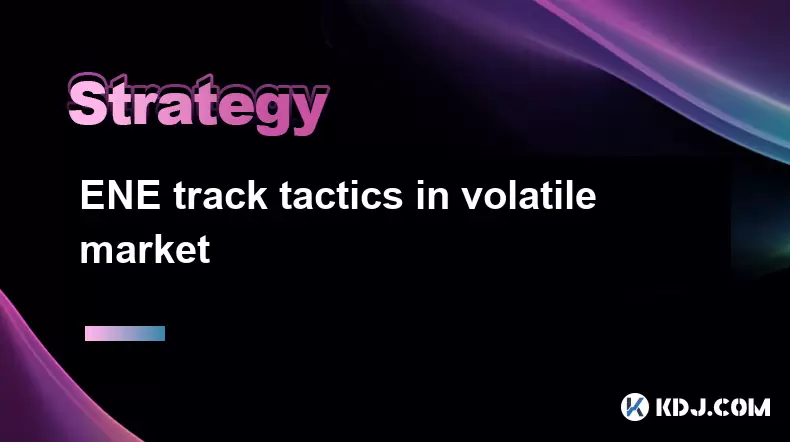-
 bitcoin
bitcoin $122025.899241 USD
-2.12% -
 ethereum
ethereum $4488.068729 USD
-4.11% -
 bnb
bnb $1315.348019 USD
8.65% -
 tether
tether $1.000457 USD
0.03% -
 xrp
xrp $2.875326 USD
-3.69% -
 solana
solana $222.043604 USD
-4.07% -
 usd-coin
usd-coin $0.999682 USD
0.00% -
 dogecoin
dogecoin $0.249887 USD
-5.62% -
 tron
tron $0.337379 USD
-2.59% -
 cardano
cardano $0.827763 USD
-5.06% -
 hyperliquid
hyperliquid $45.774531 USD
-2.43% -
 chainlink
chainlink $22.079309 USD
-5.87% -
 ethena-usde
ethena-usde $1.000156 USD
0.02% -
 sui
sui $3.482566 USD
-3.57% -
 stellar
stellar $0.386982 USD
-4.92%
ENE track tactics in volatile market
The ENE indicator, with its middle line and deviation bands, helps traders identify overbought and oversold conditions in volatile crypto markets for better trading decisions.
Jun 06, 2025 at 11:57 am

Understanding the ENE Indicator
The ENE (Envelope) Indicator is a technical analysis tool used by traders to identify potential overbought and oversold conditions in the market. It consists of three lines: a middle line, typically a moving average, and two outer lines that represent a percentage deviation from the middle line. In the context of a volatile cryptocurrency market, the ENE indicator can be particularly useful for tracking price movements and making informed trading decisions.
The middle line of the ENE indicator is often set as a simple moving average (SMA) or an exponential moving average (EMA). The upper and lower bands are calculated by adding and subtracting a fixed percentage from the middle line, respectively. For instance, if the middle line is a 20-day SMA and the deviation is set at 5%, the upper band would be the SMA plus 5%, and the lower band would be the SMA minus 5%.
Setting Up the ENE Indicator for Cryptocurrency Trading
To effectively use the ENE indicator in a volatile cryptocurrency market, it is crucial to set it up correctly in your trading platform. Here are the steps to set up the ENE indicator on a common trading platform like TradingView:
- Open your trading platform and select the cryptocurrency pair you wish to analyze.
- Navigate to the indicators section and search for the 'Envelope' or 'ENE' indicator.
- Add the ENE indicator to your chart. You will be prompted to customize the settings.
- Set the middle line to your preferred moving average type (SMA or EMA) and period (e.g., 20 days).
- Adjust the deviation percentage to suit your trading strategy. A common setting is 5%, but you may need to experiment with different values based on the volatility of the cryptocurrency you are trading.
- Confirm the settings and apply the indicator to your chart.
Interpreting ENE Indicator Signals in a Volatile Market
In a volatile cryptocurrency market, the ENE indicator can provide valuable insights into potential price reversals and trend continuations. Here's how to interpret the signals:
- Price touching the upper band often indicates that the cryptocurrency is overbought and may be due for a price correction. Traders might consider selling or taking profits at this point.
- Price touching the lower band suggests that the cryptocurrency is oversold and could be poised for a price rebound. This could be an opportunity for buying or adding to existing positions.
- Price moving within the bands indicates a consolidation phase. Traders might look for a breakout above the upper band or below the lower band to signal the start of a new trend.
ENE Track Tactics for Volatile Market Conditions
When dealing with a highly volatile cryptocurrency market, traders can employ specific tactics to leverage the ENE indicator effectively:
- Use the ENE indicator in conjunction with other technical indicators such as the Relative Strength Index (RSI) or the Moving Average Convergence Divergence (MACD) to confirm signals. For example, if the price touches the upper ENE band and the RSI is above 70, it strengthens the case for an overbought condition.
- Adjust the ENE settings based on market volatility. In a highly volatile market, you might need to increase the deviation percentage to capture wider price swings. Conversely, in a less volatile market, a smaller deviation might be more appropriate.
- Implement a trailing stop-loss strategy. When the price moves favorably after touching one of the ENE bands, use a trailing stop-loss to lock in profits as the price continues to move in your favor.
- Monitor volume alongside the ENE indicator. A breakout from the ENE bands accompanied by high trading volume can be a more reliable signal of a new trend.
Case Study: Applying ENE Tactics in a Volatile Cryptocurrency Market
To illustrate how ENE track tactics can be applied in a volatile market, let's consider a hypothetical scenario involving Bitcoin (BTC). Suppose the market is experiencing significant volatility due to macroeconomic news and regulatory developments.
- Initial Setup: You set up the ENE indicator on your Bitcoin chart with a 20-day SMA as the middle line and a 5% deviation for the upper and lower bands.
- Observation: Over the past week, Bitcoin's price has been fluctuating wildly, touching the upper and lower ENE bands multiple times.
- Trading Decision: You notice that each time the price touches the lower band, it rebounds sharply, suggesting strong buying interest at these levels. Conversely, when the price touches the upper band, it often pulls back, indicating profit-taking by traders.
- Action: You decide to buy Bitcoin when it touches the lower ENE band and set a trailing stop-loss just below the lower band to protect your position. When the price touches the upper band, you consider selling a portion of your holdings to lock in profits.
- Outcome: By following these ENE track tactics, you successfully navigate the volatile market, capitalizing on price rebounds and protecting your profits during pullbacks.
Risk Management and ENE Indicator in Volatile Markets
Risk management is crucial when trading in volatile cryptocurrency markets, and the ENE indicator can be a valuable tool in this regard. Here are some risk management strategies to consider:
- Position Sizing: Adjust your position size based on the signals provided by the ENE indicator. Smaller positions can be taken when the market is highly volatile to limit potential losses.
- Stop-Loss Orders: Use stop-loss orders to limit your downside risk. Place stop-loss orders just outside the ENE bands to protect against unexpected price movements.
- Diversification: Diversify your cryptocurrency portfolio to spread risk. While using the ENE indicator for one cryptocurrency, consider holding other assets to balance your overall exposure.
- Regular Monitoring: Continuously monitor the ENE indicator and adjust your trading strategy as market conditions change. Volatility can shift rapidly, and staying proactive is key to managing risk effectively.
Frequently Asked Questions
Q: Can the ENE indicator be used for all cryptocurrencies?A: Yes, the ENE indicator can be applied to any cryptocurrency. However, the settings may need to be adjusted based on the specific volatility and trading volume of the cryptocurrency you are analyzing.
Q: How often should I adjust the ENE indicator settings?A: The frequency of adjusting the ENE indicator settings depends on the market conditions. In highly volatile markets, you might need to review and adjust the settings more frequently, perhaps weekly or even daily, to stay aligned with current trends.
Q: Is the ENE indicator suitable for long-term trading strategies?A: While the ENE indicator is typically used for short-term trading due to its sensitivity to price movements, it can also be adapted for long-term strategies by using longer periods for the moving average and wider deviation percentages.
Q: Can the ENE indicator be used in combination with fundamental analysis?A: Yes, the ENE indicator can complement fundamental analysis. While the ENE indicator focuses on technical aspects, combining it with fundamental insights can provide a more comprehensive view of the market, helping traders make more informed decisions.
Disclaimer:info@kdj.com
The information provided is not trading advice. kdj.com does not assume any responsibility for any investments made based on the information provided in this article. Cryptocurrencies are highly volatile and it is highly recommended that you invest with caution after thorough research!
If you believe that the content used on this website infringes your copyright, please contact us immediately (info@kdj.com) and we will delete it promptly.
- BlockDAG, DOGE, HYPE Sponsorship: Crypto Trends Shaping 2025
- 2025-10-01 00:25:13
- Deutsche Börse and Circle: A StableCoin Adoption Powerhouse in Europe
- 2025-10-01 00:25:13
- BlockDAG's Presale Buzz: Is It the Crypto to Watch in October 2025?
- 2025-10-01 00:30:13
- Bitcoin, Crypto, and IQ: When Genius Meets Digital Gold?
- 2025-10-01 00:30:13
- Stablecoins, American Innovation, and Wallet Tokens: The Next Frontier
- 2025-10-01 00:35:12
- NBU, Coins, and Crypto in Ukraine: A New Yorker's Take
- 2025-10-01 00:45:14
Related knowledge

Practical parameter settings for a Bitcoin multi-timeframe moving average system
Sep 18,2025 at 10:54pm
Optimizing Timeframe Combinations for Bitcoin Trading1. Selecting appropriate timeframes is crucial when building a multi-timeframe moving average sys...

How can I filter out false breakouts in Dogecoin high-frequency trading?
Sep 22,2025 at 01:00am
Understanding False Breakouts in Dogecoin Trading1. A false breakout occurs when Dogecoin's price appears to move beyond a defined support or resistan...

Techniques for identifying tops and bottoms in the Bitcoin on-chain NVT model
Sep 20,2025 at 07:54pm
Understanding the NVT Model in Bitcoin Analysis1. The Network Value to Transactions (NVT) ratio is often described as the 'P/E ratio' of the cryptocur...

What does the surge in open interest in Bitcoincoin futures mean?
Sep 20,2025 at 11:18pm
Understanding the Surge in Dogecoin Futures Open Interest1. A surge in open interest within Dogecoin futures indicates a growing number of active cont...

How can I use the Ethereum USDT premium to gauge market sentiment?
Sep 18,2025 at 11:55pm
Understanding the Ethereum USDT Premium1. The Ethereum USDT premium refers to the price difference between USDT (Tether) traded on Ethereum-based plat...

What should I do if Ethereum staking yields decline?
Sep 20,2025 at 06:18am
Understanding the Causes Behind Declining Ethereum Staking Yields1. The Ethereum network transitioned to a proof-of-stake consensus mechanism with the...

Practical parameter settings for a Bitcoin multi-timeframe moving average system
Sep 18,2025 at 10:54pm
Optimizing Timeframe Combinations for Bitcoin Trading1. Selecting appropriate timeframes is crucial when building a multi-timeframe moving average sys...

How can I filter out false breakouts in Dogecoin high-frequency trading?
Sep 22,2025 at 01:00am
Understanding False Breakouts in Dogecoin Trading1. A false breakout occurs when Dogecoin's price appears to move beyond a defined support or resistan...

Techniques for identifying tops and bottoms in the Bitcoin on-chain NVT model
Sep 20,2025 at 07:54pm
Understanding the NVT Model in Bitcoin Analysis1. The Network Value to Transactions (NVT) ratio is often described as the 'P/E ratio' of the cryptocur...

What does the surge in open interest in Bitcoincoin futures mean?
Sep 20,2025 at 11:18pm
Understanding the Surge in Dogecoin Futures Open Interest1. A surge in open interest within Dogecoin futures indicates a growing number of active cont...

How can I use the Ethereum USDT premium to gauge market sentiment?
Sep 18,2025 at 11:55pm
Understanding the Ethereum USDT Premium1. The Ethereum USDT premium refers to the price difference between USDT (Tether) traded on Ethereum-based plat...

What should I do if Ethereum staking yields decline?
Sep 20,2025 at 06:18am
Understanding the Causes Behind Declining Ethereum Staking Yields1. The Ethereum network transitioned to a proof-of-stake consensus mechanism with the...
See all articles










































































